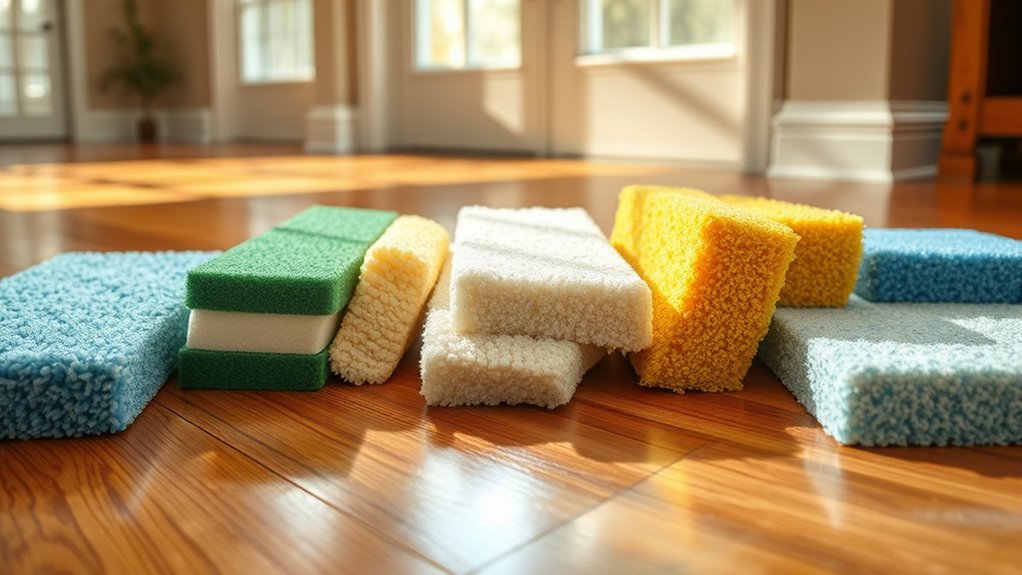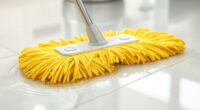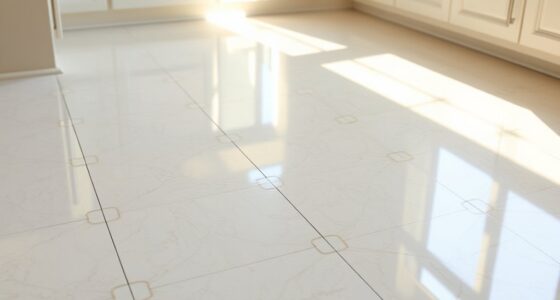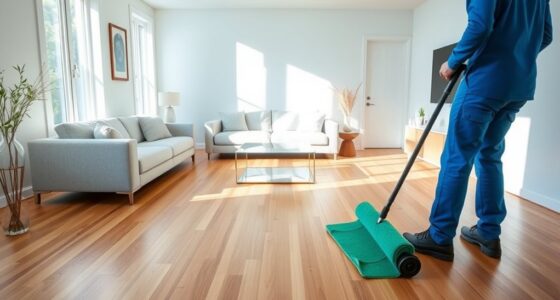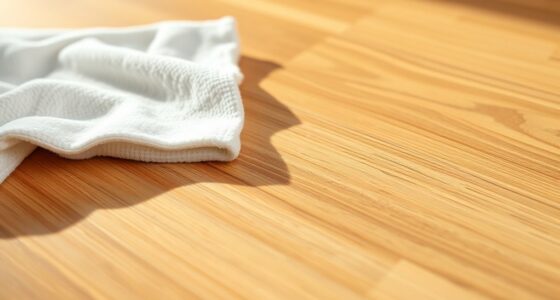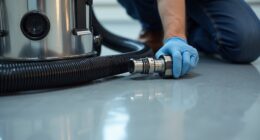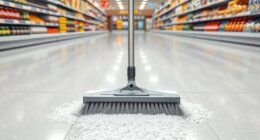To choose the right scrubbing pad for your floor, consider your surface type and cleaning needs. For durable surfaces like concrete or tile, a coarser abrasive can tackle tough grime, while delicate floors require softer pads to prevent scratches. Look for high-quality, durable pads that match the intensity of your cleaning tasks and remember to maintain them properly. Keep these tips in mind to protect your floors and achieve the best results—more guidance is just ahead.
Key Takeaways
- Match the abrasive level of the pad to your floor type and cleaning task to prevent damage.
- Choose durable pads with high-quality backing and abrasive layers for longer lifespan and cost-effectiveness.
- Select coarser abrasives for tough grime and softer abrasives for delicate surfaces to protect your flooring.
- Consider pad design features like reinforcement and fibers that enhance usability and longevity.
- Follow manufacturer recommendations and maintain pads properly to ensure optimal performance and prevent deterioration.
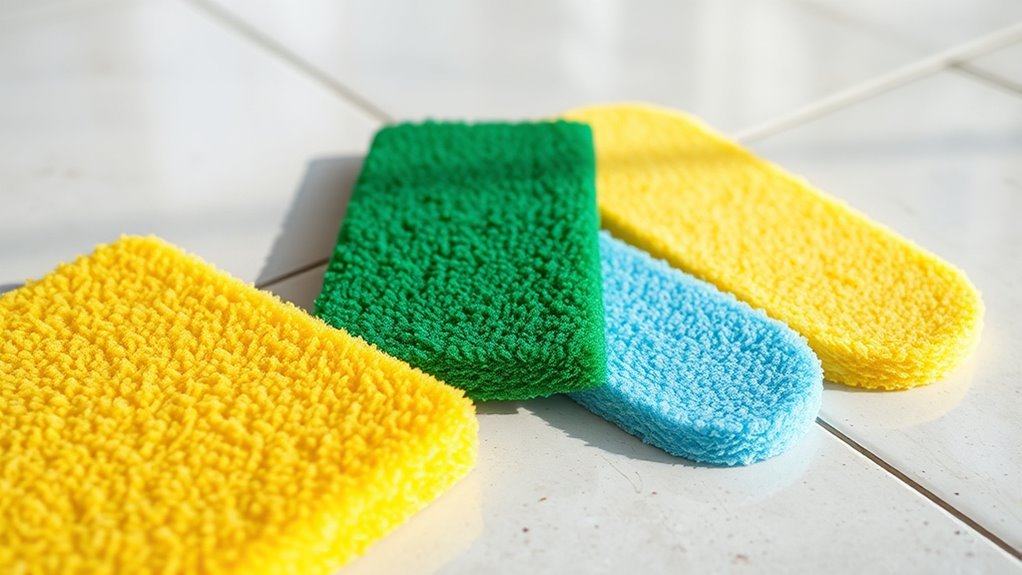
Selecting the right floor scrubbing pad is vital for effectively cleaning your floors without causing damage. The type of pad you choose directly impacts how well your floors are cleaned and how long your equipment lasts. When selecting a pad, consider the abrasive materials it’s made from, as these determine its cleaning power and suitability for different surfaces. Pads with coarser abrasives are ideal for removing stubborn grime or tough stains on durable surfaces like concrete or tile, but they can scratch softer floors such as vinyl or laminate. Conversely, softer abrasive materials are gentler and better suited for delicate surfaces, helping you avoid unwanted scratches or dulling.
Choose abrasive materials wisely to protect delicate floors while ensuring effective cleaning.
Another essential factor is pad longevity; a well-made scrubbing pad can last through multiple cleaning sessions, saving you money and reducing waste. Look for pads constructed with durable backing materials and high-quality abrasive layers that resist tearing and wear. While a more robust pad might cost a little more upfront, it pays off in the long run because it maintains its effectiveness longer, providing consistent cleaning performance. Cheaper pads tend to wear out quickly, lose their abrasive qualities, and require frequent replacements, which can become costly over time.
Matching the pad’s abrasive properties to your specific cleaning needs is key. If you’re tackling heavy-duty scrubbing tasks, opt for a pad with more abrasive materials designed to handle tough dirt and grime. For routine cleaning or light maintenance, a softer pad with finer abrasives will suffice and help preserve your floors’ finish. Additionally, consider the compatibility of the pad with your floor type. Using an overly abrasive pad on sensitive flooring can cause irreversible damage, so always check manufacturer recommendations.
Keep in mind that the pad’s design can influence its lifespan as well. Features like a reinforced backing or specialized fibers can extend its usability, especially if you’re using it regularly. Proper care also prolongs pad longevity—rinsing and drying the pad after each use prevents buildup and deterioration. Furthermore, understanding the abrasive qualities of different pads can help you select the most appropriate option for your cleaning tasks. Ultimately, choosing the right scrubbing pad involves balancing abrasive materials for effective cleaning with considerations for pad longevity and the specific surface you’re working on. When you make an informed choice, you guarantee your floors stay clean and undamaged, while your equipment remains in good shape for longer.
Frequently Asked Questions
Can Scrubbing Pads Damage My Floor’s Finish?
Yes, scrubbing pads can damage your floor’s finish if they’re too abrasive or used improperly. To guarantee floor safety, choose a pad with appropriate pad durability for your floor type. Always test a small, hidden area first, and avoid excessive pressure. Using the right pad and technique preserves your floor’s finish, preventing scratches or dullness, and keeps your floors looking their best longer.
How Often Should I Replace My Scrubbing Pad?
You should replace your scrubbing pad before it wears out completely to maintain cleaning effectiveness and protect your floor. Typically, the pad lifespan and replacement frequency depend on how often you clean and the pad’s material. If you notice fraying, loss of abrasiveness, or lingering debris, it’s time for a new one. Regularly inspecting your pad ensures peak performance and prolongs your floor’s finish. Don’t wait too long to swap it out.
Are There Eco-Friendly Scrubbing Pad Options?
Yes, eco-friendly scrubbing pads are available. You can look for options made from biodegradable materials, which break down naturally and reduce waste. Reusable options are also great, allowing you to wash and reuse them multiple times, cutting down on single-use plastic waste. These environmentally conscious choices help you clean effectively while minimizing your ecological footprint. Always check product labels for eco-friendly certifications to guarantee you’re making a sustainable choice.
Can I Use a Scrubbing Pad on Sealed Hardwood Floors?
Yes, you can use a scrubbing pad on sealed hardwood floors, but choose a soft, non-abrasive one to avoid scratches. Use it for floor polishing and dust removal, ensuring you don’t apply too much pressure. Always test in a small area first. Regular gentle scrubbing helps maintain your floor’s shine and cleanliness without damaging the seal, keeping your hardwood looking its best.
What’s the Best Way to Clean and Store Scrubbing Pads?
Wondering how to keep your scrubbing pads in top shape? Start by rinsing them thoroughly after each use with warm water and a mild detergent to remove debris and prevent odors. Once clean, let them air dry completely before storage—preferably in a cool, dry place. Use storage tips like hanging or placing them in a sealed container to avoid dirt buildup. Proper cleaning methods and smart storage guarantee your pads last longer and work better.
Conclusion
Choosing the right scrubbing pad isn’t just about cleaning; it’s about protecting your floors for the long run. Like a gentle touch that preserves beauty, the right pad balances power with care. A tough pad may scrub away grime but damage your surface, while a gentle one might miss stubborn dirt. Find that perfect middle ground, and your floors will shine without compromise. Because, in the end, the right choice makes all the difference.
